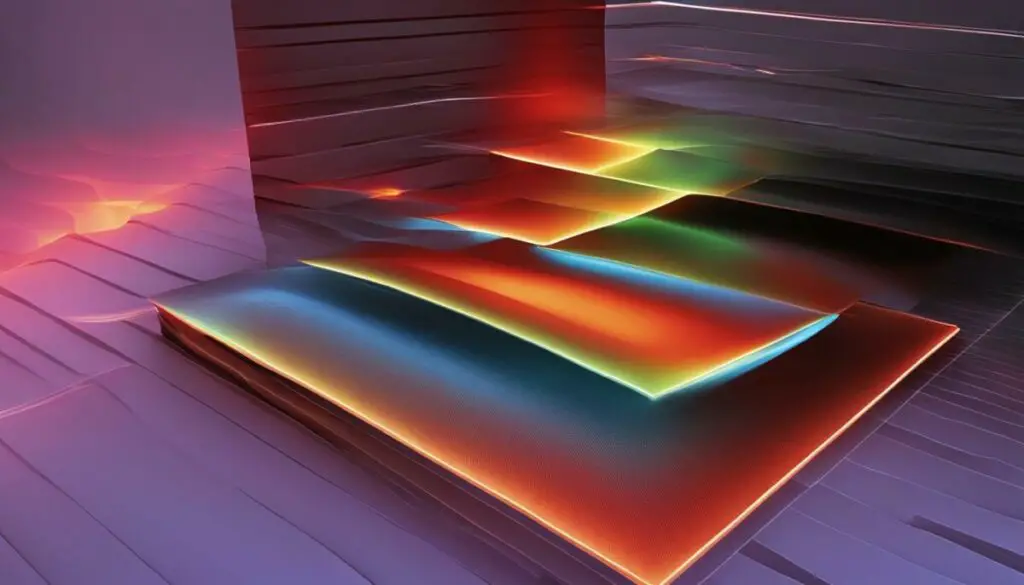Last Updated on 6 months by Francis
Contents
What is Infrared Radiation?
Infrared radiation is a form of electromagnetic radiation that is invisible to the human eye. Unlike other forms of heat transfer, such as conduction and convection, which require physical contact or the movement of air molecules, infrared radiation can travel through the air in straight lines.
When infrared radiation comes into contact with an object, it is absorbed and converted into heat. This makes it an ideal form of heat transfer for heating enclosed spaces, such as homes and offices.
Infrared heaters are devices that harness the power of infrared radiation to warm your space. They generate infrared radiation by passing an electric current through a heating element, which then emits the radiation as heat.
But how exactly does infrared radiation work, and what makes it different from other forms of heat transfer? Let’s take a closer look.
The Science of Infrared Heat Production
Now that we have a basic understanding of what infrared radiation is, let’s take a closer look at how it is generated and harnessed by infrared heaters for heating purposes. Infrared heat production is a complex process that involves the use of advanced heating elements and innovative technology.
Infrared Heat Production
Infrared heating technology uses a range of heating elements to produce infrared radiation. These heating elements include tungsten, ceramic, and quartz. One of the key advantages of infrared heating technology is that it can generate heat quickly and efficiently, making it a popular choice for many heating applications.
Unlike traditional heating methods that rely on convection or forced air to heat a space, infrared heating technology uses radiant heat to warm objects directly. This means that the heat is distributed evenly throughout the space, without any hot or cold spots.
Types of Heating Elements
There are different types of heating elements used in infrared heaters, each with its own unique characteristics and benefits. The most common types of heating elements include:
| Heating Element | Description |
|---|---|
| Tungsten | Tungsten heating elements are known for their durability and long lifespan. They are often used in industrial applications, such as drying and curing processes. |
| Ceramic | Ceramic heating elements are common in residential and commercial settings. They are cost-effective and can heat up quickly, making them a popular choice for many applications. |
| Quartz | Quartz heating elements are known for their rapid heating and cooling capabilities. They are often used in applications where precise temperature control is required, such as in food processing and scientific research. |
Each of these heating elements has its own advantages and disadvantages, and the choice of heating element will depend on the specific heating needs of the application.
The Role of Reflectors
Reflectors are an essential component of an infrared heater, and they play a crucial role in directing the infrared radiation towards the desired target. The reflector is positioned behind the heating element, and it reflects the radiation outward toward the room.
For optimal heating efficiency, the reflector should be angled properly to direct the radiation towards the target. The distance between the heating element and the reflector can also affect the effectiveness of the heat distribution.
In conclusion, infrared heat production is a highly specialized process that involves the use of advanced heating elements and innovative technology. Understanding the different types of heating elements and the role of reflectors can help you choose the right infrared heater for your specific needs.
Key Components of an Infrared Heater

Infrared heaters differ from traditional heating systems due to their unique components and heating technologies. Understanding the key components of an infrared heater is essential to appreciate how they function and generate heat efficiently. Here are the primary components:
1. Heating Element
The heating element is the main component that generates heat in an infrared heater. The element is made up of a material that heats up quickly and radiates infrared energy. The most common materials used in heating elements are carbon fiber, ceramic, and quartz.
The heating elements used in infrared heaters are designed to produce a specific wavelength of infrared radiation. This is because different wavelengths are more efficient at heating certain objects, which affects the heater’s performance and energy efficiency. Carbon fiber elements, for instance, produce long-wave infrared radiation that is perfect for heating objects in the room, while short-wave infrared radiation from quartz elements is suitable for spot heating.
2. Reflectors
Reflectors play a crucial role in the efficiency of an infrared heater. They are designed to reflect the infrared radiation emitted by the heating element towards the objects in the room, ensuring maximum heat distribution. Reflectors are typically made up of polished aluminum, which has high reflectivity and low emissivity, minimizing heat loss.
The shape, size, and placement of the reflector also affect the heat distribution of the infrared heater. A larger, curved reflector can distribute heat over a broader area, while a smaller, angled one provides more targeted heating. Reflectors that are positioned closer to the heating element can also improve efficiency by redirecting any heat that would otherwise be lost.
3. Fan
Some infrared heaters are equipped with fans that help to distribute heat quickly and effectively throughout the room. The fan works by blowing air across the heating element, causing warm air to circulate and heat objects in the room. Fans are particularly useful in larger rooms or spaces with high ceilings, where heat distribution can be a challenge.
4. Housing
The housing of an infrared heater is the outer casing that surrounds the internal components. It is usually made up of materials such as metal, plastic, or wood, and serves to protect the components and reflect the infrared radiation. The housing design also affects the heat distribution by directing the heat towards the objects in the room.
| Component | Function | Materials |
|---|---|---|
| Heating Element | Generates infrared radiation | Carbon fiber, ceramic, quartz |
| Reflectors | Reflects infrared radiation towards objects | Polished aluminum |
| Fan | Distributes heat throughout the room | Plastic, metal |
| Housing | Protects internal components and directs heat | Metal, plastic, wood |
Understanding the key components of an infrared heater is essential to appreciate how they function and generate heat efficiently.
Now that you have learned about the essential components that make up an infrared heater, you can better understand how they work and provide efficient heating in your space. In the next section, we will explore the energy transfer process in infrared heaters and how they achieve optimal heat distribution.
Energy Transfer in Infrared Heaters

Energy transfer is a crucial process in infrared heating technology, enabling effective and efficient heating of a space. Unlike traditional heating methods that rely on convection or conduction, infrared heaters transfer energy through the emission of infrared radiation, which travels through the air and interacts with objects in the room to create warmth.
So, how does energy transfer work in infrared heaters? It all starts with the heating element, which emits infrared radiation in the form of heat waves. These waves are then absorbed by objects in the room, such as furniture, walls, and floors. As the objects absorb the heat, they warm up and release their energy back into the air, creating a cycle of heat transfer.
This process is highly efficient because it doesn’t rely on heating the air, which can quickly escape through drafts or ventilation. Instead, the infrared radiation travels directly to the objects in the room, creating a comfortable and even heat distribution.
Infrared Radiation vs. Convection
One of the main advantages of infrared heating technology is its ability to provide a more consistent and comfortable heat compared to traditional convection heating methods. Convection heaters rely on heating the air, which rises and then falls as it cools, creating pockets of hot and cold air in a room.
In contrast, infrared heaters emit heat waves that travel directly to the objects in the room, creating a more even heat distribution without any hot or cold spots. This method of heat transfer also reduces the circulation of dust and other particles in the air, making it a healthier and more hygienic heating solution.
Overall, the energy transfer process in infrared heaters is highly effective and efficient, providing a comfortable and even heat distribution. By harnessing the power of infrared radiation, these heaters offer a healthier, more hygienic, and cost-effective heating solution for any space.
Achieving Optimal Heat Distribution

One of the key benefits of infrared heating technology is the even heat distribution it provides throughout a space. Unlike traditional heating methods, infrared radiation travels through the air and interacts with objects, transferring heat in a more efficient and targeted way.
An important factor in achieving optimal heat distribution is the placement of the infrared heater. By installing the heater in the right location, you can ensure that the infrared radiation is evenly spread without causing any hot or cold spots. In general, it is recommended to install infrared heaters on a wall or ceiling, at a height of 6-8 feet from the ground, and facing towards the center of the area to be heated.
Another factor that contributes to heat distribution is the use of reflectors in the infrared heater. Reflectors help to direct the infrared radiation towards the intended area, increasing the coverage and efficiency of the heater. Depending on the model of the infrared heater, you may be able to adjust the angle and position of the reflectors to further customize the heat distribution.
Finally, it is important to consider the size and output of the infrared heater when selecting one for your space. A larger room or area will require a heater with a higher output to achieve the desired temperature, while a smaller space can be adequately heated with a lower output heater. By selecting the right size and output for your space, you can ensure that the heat is evenly distributed and provide optimal comfort and energy efficiency.
Affordable and Comfortable Heating with Infrared Heaters

Are you tired of high energy bills and uneven heating in your home? Consider upgrading to infrared heaters for a cost-effective and comfortable solution. With infrared heating technology, you can experience the warmth of the sun’s rays indoors without the harmful UV radiation.
Infrared heaters use electricity to power advanced heating elements that emit infrared radiation, which is then absorbed by objects and surfaces in the room. This creates an even, comfortable heat that does not rely on heating the air, making it a more efficient and effective heating solution.
But the benefits of infrared heating technology don’t stop there. Here are just a few reasons why so many homeowners are making the switch to infrared heaters:
- Energy Efficiency: Infrared heaters use less electricity than traditional heating methods, resulting in lower energy bills and a reduced carbon footprint.
- Improved Comfort: Infrared heat is gentle and even, eliminating cold spots and reducing the dryness and irritation often associated with other forms of heating.
- Health Benefits: Infrared heat can improve circulation, soothe aches and pains, and even boost your immune system.
- Low Maintenance: Infrared heaters have no moving parts, so there’s less chance of something breaking down or needing repair. Plus, they don’t produce any harmful emissions or require any fuel.
Whether you’re looking to heat a small bedroom or a large living area, there’s an infrared heater to meet your needs. Choose from a variety of models, sizes, and features to find the perfect fit for your home.
| Model | Area Coverage | Features |
|---|---|---|
| Model A | Up to 500 sq. ft. | Adjustable thermostat, remote control |
| Model B | Up to 1000 sq. ft. | Timer, oscillation, safety shut-off |
| Model C | Up to 1500 sq. ft. | Wall mountable, overheat protection |
No matter which model you choose, be sure to select one with safety features such as overheat protection and tip-over shut-off. It is also essential to consider the energy rating and how it will affect your utility bills.
Upgrade your home heating system with an infrared heater and enjoy the benefits of energy-efficient, comfortable, and healthy warmth all winter long.
Factors to Consider When Choosing an Infrared Heater
When selecting an infrared heater, there are a variety of factors to consider to ensure that you are choosing the right one for your specific needs.
First and foremost, consider the size of the space you wish to heat. Infrared heaters are available in various sizes, and it’s important to choose one that is appropriate for your room. If the heater is too small, it may not provide sufficient heat, while a unit that is too large may be wasteful and inefficient.
Next, consider the safety features of the infrared heater. Look for heaters with automatic shut-off features to prevent overheating or tipping. This is especially important if you have small children or pets in your home.
Energy efficiency is also an important factor to consider. Look for heaters with high energy efficiency ratings to ensure that you’re getting the most heat for your energy dollar. Infrared heaters are typically more efficient than traditional heating methods, but it’s still important to compare different models.
Another important consideration is the durability and longevity of the infrared heater. Look for models with a solid construction and a warranty to ensure that you’re making a wise investment in a long-lasting heating solution.
Finally, consider any additional features that may be important to you, such as oscillation, remote control, or programmable settings. These added features can enhance your comfort and convenience.
Comparison Table of Infrared Heaters
| Brand | Size (inches) | Safety Features | Energy Efficiency Rating | Price |
|---|---|---|---|---|
| Brand A | 12 x 16 | Automatic shut-off | 4.5/5 | $100 |
| Brand B | 18 x 20 | Tip-over protection | 4/5 | $150 |
| Brand C | 24 x 20 | Overheat protection | 5/5 | $200 |
Use this table as a guide when comparing different infrared heater models. Take note of the size, safety features, energy efficiency rating, and price to make an informed decision on the best model for your needs.
Conclusion
By now, you should have a good understanding of how infrared heaters work and how they can benefit your home.
Consider the Energy Efficiency
Infrared heating technology is a cost-effective solution in terms of energy efficiency and cost savings. With infrared heaters, you can reduce your energy bills while still enjoying a comfortable and cozy environment.
Enjoy Even Heat Distribution
The even heat distribution provided by infrared heaters is essential for a comfortable living environment. Unlike traditional heating methods, infrared heaters ensure that there are no hot or cold spots in your room.
Choose the Right Infrared Heater
When selecting an infrared heater, consider the size of the room you want to heat, the safety features, and the energy rating. With these factors in mind, you can find the perfect infrared heater that meets your specific needs and preferences.
Thank you for reading this guide to understanding infrared radiation and infrared heaters. We hope that this information has been helpful and that you can now make an informed decision about whether an infrared heater is right for your home. Stay warm!
FAQ
What is Infrared Radiation?
Infrared radiation is a form of heat transfer that is invisible to the naked eye. Unlike other forms of heat, such as conduction or convection, infrared radiation does not require direct contact or a medium to travel through. Infrared heaters harness this radiation to provide warmth in a space.
How does infrared radiation differ from other forms of heat transfer?
Infrared radiation differs from other forms of heat transfer because it does not rely on physical contact or the movement of air. Instead, it directly heats objects and surfaces, which then radiate heat into the surrounding space. This method of heat transfer ensures even warmth without creating drafts or drying out the air.
How is infrared radiation generated in infrared heaters?
Infrared radiation is generated in infrared heaters through the use of advanced heating elements. These elements, such as quartz tubes or ceramic plates, emit infrared radiation when heated to high temperatures. The radiation is then emitted and distributed throughout the room, providing efficient and comfortable heat.
What are the key components of an infrared heater?
The key components of an infrared heater include the heating element, reflectors, and a housing or enclosure. The heating element, as mentioned earlier, generates the infrared radiation. Reflectors help direct and focus the radiation, maximizing its efficiency. The housing or enclosure ensures safety and helps distribute the heat evenly.
How does energy transfer occur in infrared heaters?
Energy transfer in infrared heaters happens when the heating element emits infrared radiation. This radiation then travels through the air, without heating it, until it reaches objects and surfaces in the room. Once the radiation makes contact with these objects, it is absorbed and converted into heat, warming the surrounding area.
How do infrared heaters achieve optimal heat distribution?
Infrared heaters achieve optimal heat distribution by emitting infrared radiation that travels in straight lines. This radiation interacts with objects in its path, ensuring that the heat is evenly spread throughout the space. This method of heat distribution eliminates hot and cold spots, creating a comfortable environment.
What are the benefits of using infrared heaters?
There are several benefits to using infrared heaters. Firstly, they are energy-efficient, as they directly warm objects instead of wasting energy heating the air. This leads to cost savings on energy bills. Additionally, infrared heat is gentle and does not dry out the air, making it comfortable for occupants. It can also provide health benefits, such as improved blood circulation.
What factors should I consider when choosing an infrared heater?
When selecting an infrared heater, consider factors such as the size of the space you want to heat, the desired heating capacity, and safety features. Look for energy ratings to ensure efficiency and consider additional features like programmable timers or remote controls. It’s also important to choose a reputable brand and consider customer reviews.
In conclusion, what have we learned about infrared heaters?
In conclusion, we have learned that infrared heaters harness invisible infrared radiation to provide efficient, even heat in a space. They differ from other forms of heat transfer, such as conduction or convection, and offer benefits like energy efficiency and optimal heat distribution. Consider infrared heating technology for a comfortable and cost-effective heating solution in your home.









